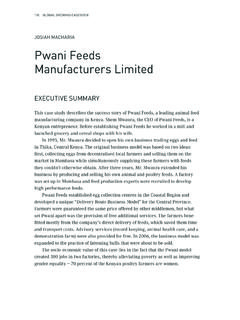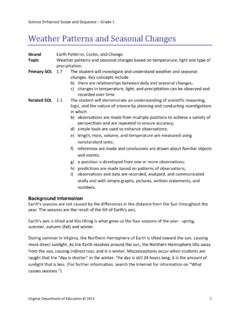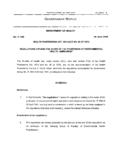Transcription of The Insect Collector’s Guide Entomological Society of Alberta
1 The Insect collector s GuideEntomological Society of McMullen (1965) Lysyk (1995, revision)This publication can be found on-line at is the study of and preserving insects is abasic part of this study and is one of thebest ways to learn about insects, howthey live and how they affect often start collecting insects forthe fun of it and then want to know moreabout the insects collected, their correctscientific and common names, and howthey spend their of InsectsInsects are the most numerous anddiverse group of animals. Over 790,000species have been described, far morethan for any other animal or plant example, there are about 80,000species of molluscs (clams, snails andsquids), 55,000 species of Arachnids(spiders, scorpions, ticks) and 54,000species of vertebrates (birds, mammals,fish, reptiles and amphibians).
2 Theorder Coleoptera (beetles) has 350,000species, Diptera (flies) has 120,000species, Lepidoptera (moths andbutterflies) has 112,000 species andHymenoptera (bees and wasps) has108,000 such large numbers, it is notsurprising that insects play a number ofimportant ecological roles. Insects occurat all levels of the food web, (except asprimary producers) and play importantroles as detritivores (scavengers),herbivores (plant feeders), predators,and can be important pests inagriculture, forestry and homes, and canthreaten human health.
3 Populations ofinsects can reach high numbers andcause a significant amount of damageunless control measures are takenagainst them. Insects also have avariety of beneficial roles. They arenecessary for pollinating many plants,including important fruit and vegetablecrops. Insects can also feed on otherinsects and provide checks on thepopulations of pest insects, preventingthem from reaching damaging control agents can bepurchased and used in agriculture andthe home garden to reduce pesticide themselves are the basic foodfor many other organisms such as birds,fish, and mammals.
4 Trout sportsfisheries depend heavily on populationsinsects. Caddisflies, stoneflies,mayflies, dragonflies, damselflies,mosquitoes, midges, and beetles are allprey for trout. Insects are also sourcesof human food in many areas. Locustsand grasshoppers are eaten in Orientalcountries, giant skipper larvae (65 mmlong) are eaten in Mexico and beetles,ants, termites and caterpillars are eatenin Africa and Australia. In addition tofood, insects also provide a largenumber of commercial products such ashoney, beeswax, shellac, silk and directly affect human healthby transmitting important diseases suchas malaria, typhus, plague and yellowfever.
5 Stinging and biting insects cancause annoyance, parasitize humans,inject venom and produce is important to remember that thereare only a few thousand different speciesof insects that warrant a reputation asdestructive insects which are so harmfulto humans, crops, stored foods anddomestic animals that steps are taken tocontrol them. Several thousand speciesof insects can be considered beneficial,but the majority of insects do neitherappreciable harm nor good, and can beconsidered indifferent insects. Usefulinsects can become destructive orindifferent, or vice versa, by a change in2the balance of nature.
6 Sometimes thisresults from human activities such asclearing forests and breaking farm landor from nature's changing climate must always remember to be onguard by knowing all we can aboutinsects to be ready when an indifferentinsect or a good Insect AND STRUCTUREA lmost all insects start life as an egg,although a few species bear live eggs are usually as small as orsmaller than the head of a pin. Theirshape is various among species as arethe color and texture of the egg and related insects enclosea number of eggs within one egg lay their eggs on long stalksso the first larva cannot eat the othereggs before they hatch.
7 Some specieslay only a few eggs and others manythousands. Ordinarily, only one insecthatches from one egg but severalthousand insects may develop from asingle egg of some parasites. Most eggsare laid close to or on the food theyoung require, but some are scatteredrandomly throughout the larva hatches from an egg anddevelops into the skin of an Insect is somewhatrigid and acts as its skeleton, but alsolimits the amount of growth that canoccur. As the Insect feeds, it grows untilits skin can no longer stretch.
8 It thenstops feeding for a short period andcompletes the development of a new andlarger (looser) skin underneath the oldone. It swells its body by swallowing airor water and also by flexing its splits the old skin and the insectcrawls out. This process is calledmolting. Every time an immature insectmolts it may change its appearanceslightly as well as becoming larger. Theform of an Insect between molts is calledan instar. All immatures of a certaininstar of a species will look the number of instars that insects mustgo through before it reaching maturity(adult stage), varies among species, butis commonly three to five.
9 Immature insects undergo changes inform before reaching the adult process is called metamorphosis,which in Greek means change of has three basic first type is found in the mostprimitive insects and is calledametablous metamorphosis becausethere is no metamorphosis. The newlyhatched Insect looks almost exactly likethe adult Insect except that it is are ametabolous second type is hemimetabolousmetamorphosis. The newly hatchedinsect is called a nymph which closelyresembles the adult Insect , except it doesnot have wings.
10 The wings appear assmall pads on the back of the nymph andget larger at each moult. When thenymph reaches the size of an adult, itmolts to the adult form with fully grownwings. Grasshoppers, lice and bugs arehemimetabolous third type of metamorphosis isholometabolous metamorphosis orcomplete metamorphosis. The insecthatches from the egg as a larva, whichdoes not resemble the adult Insect . Someexamples of larvae are caterpillars, flymaggots, wireworms, and mosquitowrigglers. After a larva reaches full sizeit turns into a pupa.




